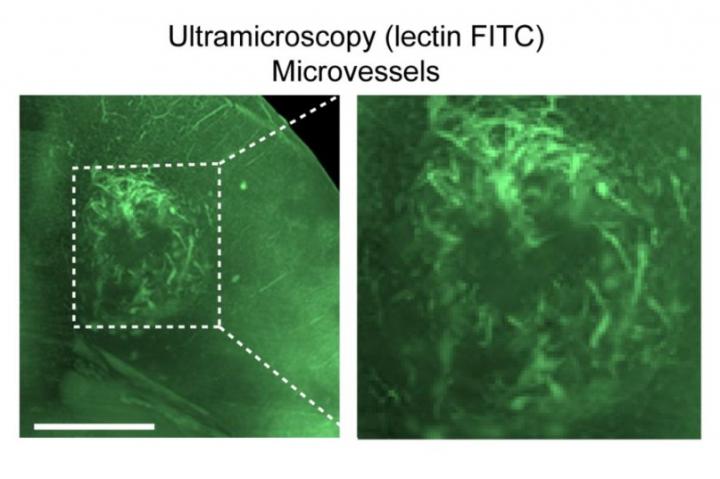Scientists create imaging 'toolkit' to help identify new brain tumor drug targets

Brain tumor microvessels are visualized using dual-color ultramicroscopy. Credit: Breckwoldt, Bode et al.
“Gliomas are highly malignant brain tumours with poor prognosis,” says Michael Breckwoldt, a physician-scientist and one of the lead authors of the paper from the University of Heidelberg.
“Many efforts have been made to develop therapies against the growth of blood vessels and therefore 'starve' tumours of their resources, but they are not entirely effective. Improved imaging techniques that faithfully show the vessel architecture, including their growth, structure and density, and the effects of treatments in a non-invasive way are therefore needed to inform the development of future clinical trials.”
In their study in mice, the team combined an MRI approach in vivo with ultramicroscopy of ex vivo whole brains cleared for imaging.
The technique is based on T2*-weighted (T2*-w) MRI images, one of the basic pulse sequences in MRI, with high resolution to allow for substantially more detail than conventional T2*-w imaging. Pre- and post-contrast MR scans were performed to define the growth of vessels during glioma development in two different glioma models.
The team further mapped the development of vessels by dual-colour ultramicroscopy of whole, cleared brains. Using fluorescent labelling of microvessels, they collected complementary 3D MR and ultramicroscopy data sets (dubbed the 'MR-UM'), which could be compared side-by-side.
“MR-UM can be used as a platform for three-dimensional mapping of single vessels and detailed measurements of the growth of newly formed vessels over time,” Dr. Breckwoldt explains.
“This provides a better understanding of the underlying mechanisms of existing treatment and could help identify novel targets for future drug development,” adds Dr. Julia Bode, co-lead author from the German Cancer Research Centre.
The team also used the toolkit to assess the effects of existing anti-vascular endothelial growth factor (anti-VEGF) treatments or radiation therapy on the vessel compartment within the glioma models. They found that such treatments are insufficient to halt tumour growth in mice, which mirrors current human studies.
“Dual inhibitors of vessel growth are now being developed and our toolkit could also help assess their therapeutic effects in detail,” says Bode.
The T2*-weighted imaging sequence and UM studies in ex vivo brains are at present only suitable for mapping tumour vessels in a preclinical setting. The team anticipates, however, that future studies using high-field clinical MR systems should enable possible translation of the MRI approach to the clinical arena. Furthermore, specimens taken for clinical diagnosis could be studied using ultramicroscopy, making the full MR-UM toolkit a potential player in a clinical setting.
About eLife
eLife is a unique collaboration between the funders and practitioners of research to improve the way important research is selected, presented, and shared. eLife publishes outstanding works across the life sciences and biomedicine — from basic biological research to applied, translational, and clinical studies. All papers are selected by active scientists in the research community. Decisions and responses are agreed by the reviewers and consolidated by the Reviewing Editor into a single, clear set of instructions for authors, removing the need for laborious cycles of revision and allowing authors to publish their findings quickly. eLife is supported by the Howard Hughes Medical Institute, the Max Planck Society, and the Wellcome Trust. Learn more at elifesciences.org.
Media Contact
All latest news from the category: Health and Medicine
This subject area encompasses research and studies in the field of human medicine.
Among the wide-ranging list of topics covered here are anesthesiology, anatomy, surgery, human genetics, hygiene and environmental medicine, internal medicine, neurology, pharmacology, physiology, urology and dental medicine.
Newest articles

Properties of new materials for microchips
… can now be measured well. Reseachers of Delft University of Technology demonstrated measuring performance properties of ultrathin silicon membranes. Making ever smaller and more powerful chips requires new ultrathin…

Floating solar’s potential
… to support sustainable development by addressing climate, water, and energy goals holistically. A new study published this week in Nature Energy raises the potential for floating solar photovoltaics (FPV)…

Skyrmions move at record speeds
… a step towards the computing of the future. An international research team led by scientists from the CNRS1 has discovered that the magnetic nanobubbles2 known as skyrmions can be…





















